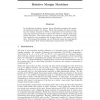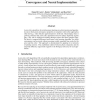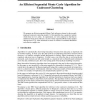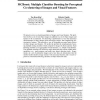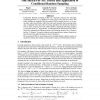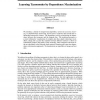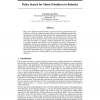133
click to vote
NIPS
2008
15 years 2 months ago
2008
Semantic hashing[1] seeks compact binary codes of data-points so that the Hamming distance between codewords correlates with semantic similarity. In this paper, we show that the p...
NIPS
2008
15 years 2 months ago
2008
In classification problems, Support Vector Machines maximize the margin of separation between two classes. While the paradigm has been successful, the solution obtained by SVMs is...
NIPS
2008
15 years 2 months ago
2008
Psychophysical experiments show that humans are better at perceiving rotation and expansion than translation. These findings are inconsistent with standard models of motion integr...
137
click to vote
NIPS
2008
15 years 2 months ago
2008
Actor-critic algorithms for reinforcement learning are achieving renewed popularity due to their good convergence properties in situations where other approaches often fail (e.g.,...
NIPS
2008
15 years 2 months ago
2008
We propose an efficient sequential Monte Carlo inference scheme for the recently proposed coalescent clustering model [1]. Our algorithm has a quadratic runtime while those in [1]...
109
click to vote
NIPS
2008
15 years 2 months ago
2008
We present a new co-clustering problem of images and visual features. The problem involves a set of non-object images in addition to a set of object images and features to be co-c...
116
click to vote
NIPS
2008
15 years 2 months ago
2008
Hierarchical probabilistic modeling of discrete data has emerged as a powerful tool for text analysis. Posterior inference in such models is intractable, and practitioners rely on...
113
click to vote
NIPS
2008
15 years 2 months ago
2008
Conditional Random Sampling (CRS) was originally proposed for efficiently computing pairwise (l2, l1) distances, in static, large-scale, and sparse data. This study modifies the o...
115
click to vote
NIPS
2008
15 years 2 months ago
2008
We introduce a family of unsupervised algorithms, numerical taxonomy clustering, to simultaneously cluster data, and to learn a taxonomy that encodes the relationship between the ...
111
click to vote
NIPS
2008
15 years 2 months ago
2008
Many motor skills in humanoid robotics can be learned using parametrized motor primitives as done in imitation learning. However, most interesting motor learning problems are high...

